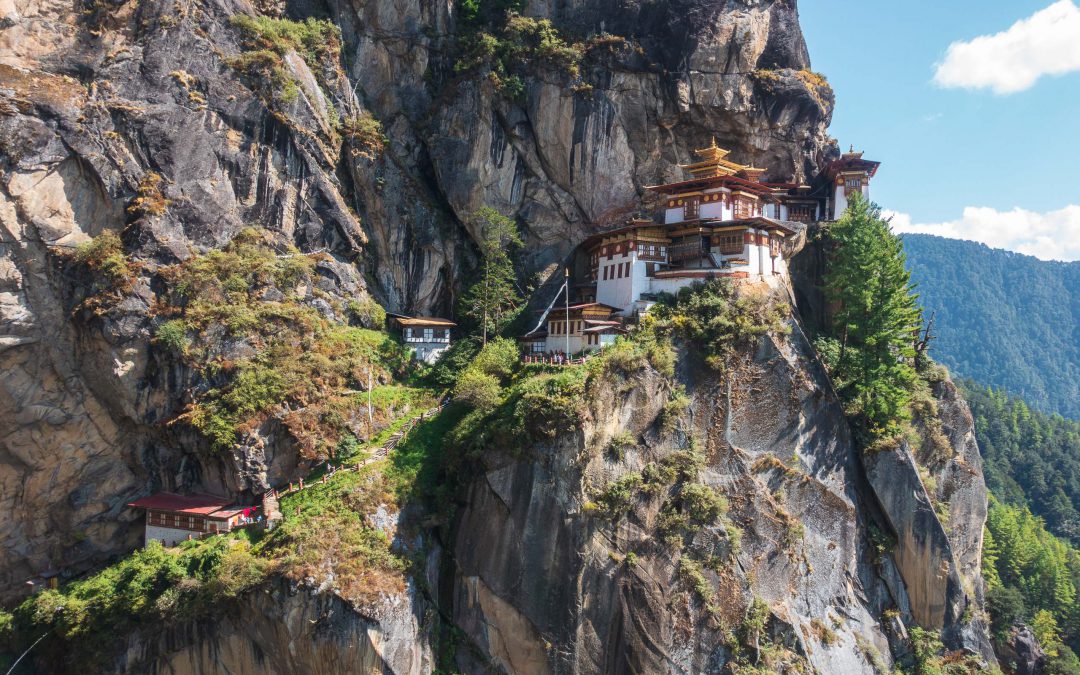High up in the Himalaya mountains overlooking the Paro valley is a Buddhist monastery clinging to the side of a rock face. Paro Taktsang commonly referred to as the Tiger’s Nest is a must-see for any visit to Bhutan. It is surreal and looks like something you could only imagine seeing in a movie. It is that quintessential Buddhist monastery high up in the mountains where your favorite fictional hero goes to train or obtain some spiritual guidance. The architecture and setting are breathtaking. Honestly, the construction is a marvel that boggles the mind. How did they seriously do it? Just another testament to what we as humans are capable of when we are motivated. To just say it is impressive would be doing it an incredible disservice.
Things to know before hiking to the Tiger’s Nest:
- Beginning elevation approximately 6,700 feet.
- Monastery elevation is 10,240 feet.
- Up and back is roughly six miles and takes 4-6 hours.
- The intensity of the hike is moderate.
- Trail, mostly in the shade of trees, has a moderately steep grade with many switchbacks.
- The final stretch to the monastery involves stairs with around 700 steps.
- Suitable for adults and children (maybe 10 or over)
- At these altitudes, you will start to feel the effects of less oxygen in the air (it can be harder to catch your breath, or you may get winded quicker)
- Dress appropriately. It is likely to be cooler at the top than it is at the start of the hike.
- Start Early! Have a good Breakfast! Wear comfortable shoes! Stay hydrated! Use a walking stick or trekking pole!
For most trips in Bhutan, your guide will recommend that the Tiger’s Nest be one of the last things you see and do. It gives your body time to adjust to the higher altitudes and can make the trek to +10,000 feet a bit more comfortable. We, however, had just come from Nepal and our bodies were pretty well acclimatized to the Himalayan altitudes. So we opted to do it on the second day of our stay.
I want to emphasize that before this trek neither Jessica nor I were mountaineers or serious hiking backpackers. Jessica is asthmatic and has dealt with it her whole life. It is something she was very nervous about with this trek. To top it off, she only had about four hours of sleep the night before. I, on the other hand, love hiking and regularly hike the smaller mountains around the places we’ve lived. But, I have never reached a summit beyond 6,000 feet. This was going to be a challenge for both of us, and we knew it. We planned to simply take it nice and easy… one step at a time.
Paro Taktsang Hike
Our morning started early with a hearty breakfast and then a quick drive through the forest to the trailhead. From there we got our first view of the Tiger’s Nest. It was hard to make out, but far in the distance perched on a precarious cliff, we could faintly see the monastery through the clouds. From where we stood it seemed an unbelievable destination to get to. The trailhead was busy with many other trekkers and their guides. There were prayer flags strewn about the trees and a corral of mules getting loaded up with supplies. Some even saddled up for carrying people. I saw Jessica enviously eye the people who were getting ready to ride the Mules, but Jemme (our guide) informed us that the mules can actually be dangerous. They are animals and therefore unpredictable. A fall from a mule could end in a severe injury, and it has happened.
With walking sticks in hand, we set off along the trail. The forest was beautiful with the fragrance of pine accompanying each breath we took. Bhutan really felt like it had the freshest air we’ve ever breathed. It was cool in the shade as we walked along and Jessica was glad to have some ear warmers. Our pace was nice and easy. We took breaks when we needed them and were more focused on the journey than getting to the destination in record time.


Our pace allowed us to really appreciate the different kind of trek we were on. There are prayer flags everywhere along the trail. When the breeze blew, we would hear the sounds of the flags flapping every bit as much as the trees swaying and leaves rustling. It is an extraordinary blend of nature and spirituality. Something I resonate well with. The trail took us over a mountain stream or two and passed by various prayer stupas. One in particular housed a large prayer wheel that was powered by water. Built overtop a creek, the water traveled through the stupa and turned the prayer wheel like a water mill.


From this point on we began to notice the effects of less oxygen in the air and some minor side effects from the altitude. It wasn’t anything crippling by any means, but Jessica was feeling the shortness of breath. With patience and perseverance, we pressed on. Jemme kept alluding to a ‘cafe’ we were going to stop at. We assumed he was just having a bit of fun with us and did not take him seriously. But, to our surprise, after quite a few switchbacks we arrived at a small building nestled in the pine trees. The cafe did exist, and we were glad for it. We along with several others making the trek up to monastery that day sat and rested at tables along a balcony that had a lovely view of the Tiger’s Nest. It was a welcomed break. To help rejuvenate our bodies, we sipped on warm tea and nibbled on some biscuits while we met and talked to the other travelers around us.

It is always so interesting to hear other peoples stories and learn about how or what in their lives led them to be in the same place as us that day. We met a guy from the USA who was a recovering alcoholic, and this trip for him happened short notice; with minimal knowledge of what to expect from Bhutan. He was glowing from all he had seen, learned and felt while in Bhutan. For him, this was a journey on re-discovering himself. You never really know how great a story someone has to tell unless you ask.
Our break was short lived. Jemme soon came by and motivated us to our feet. We had our final push ahead of us! Leaving the cafe, we traveled up a few more switchbacks and arrived at a set of stairs that hugged the side of the mountain ending at the monastery. We had never seen anything like it before. Jemme let us know there were around 700 steps to the monastery gates. With the end in sight, we took the stairs down into a canyon along a large waterfall and then up to the gates of the monastery.

Beyond those gates, we were in a holy sanctuary. Jemme led us to one of the quite temple rooms where we sat at the feet of a monk who was presiding there. We meditated, paid our respects and then received a blessing from the monk before us. There in those moments, it felt as though time stopped for us. Maybe it was the strong incense we were breathing in or some effects of altitude on our judgment… whatever it was, looking back now it was a timeless experience. We were humble pilgrims who trekked up into the clouds in search of nothing in particular and found serenity on these hallowed grounds.
We explored a bit more of the monastery. Each room was dimly lit with huge wood-paneled floors, massive wooden pillars and ornate tapestries covering the walls. Jemme took us down to a small cold and damp cave. There, according to legend, is the very place where Guru Rinpoche came from Tibet on the back of a flying tigress. There in that very cave he meditated and emerged as the eight manifestations. In Tibet, Bhutan and the surrounding area it is believed that he is the second Buddha.
Jemme led us out of the cave and back through the monastery. It was time to start our journey back down the mountain. We were, deep down, reluctant to leave but we were satisfied to be leaving with far more than we intended to get from our visit.
Our trip down was much easier and faster than our journey on the way up. We were elated by the experience and also very excited to have reached a new altitude milestone of over 10,000 feet. The best part… doing it together. It undoubtedly wasn’t easy, but the rewards were every bit worth the effort.



